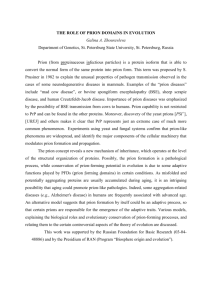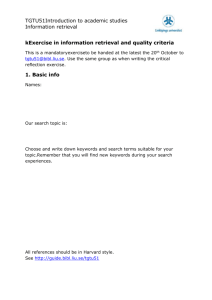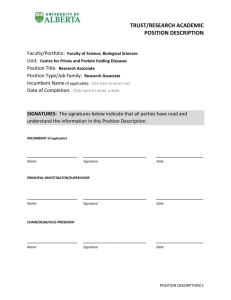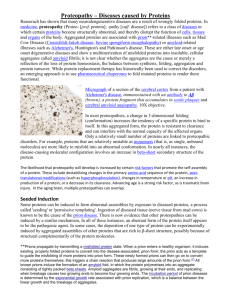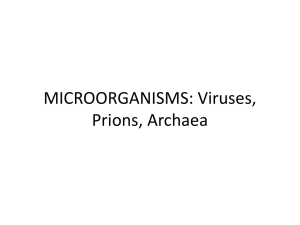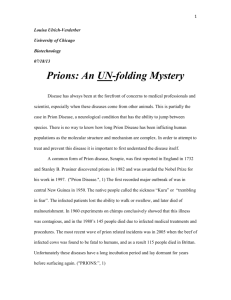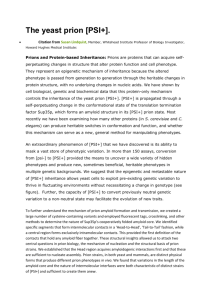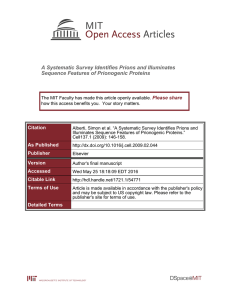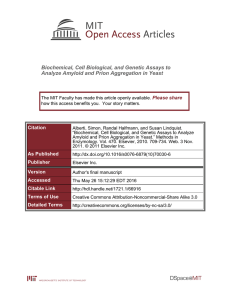QnAs with Susan L. Lindquist Please share
advertisement
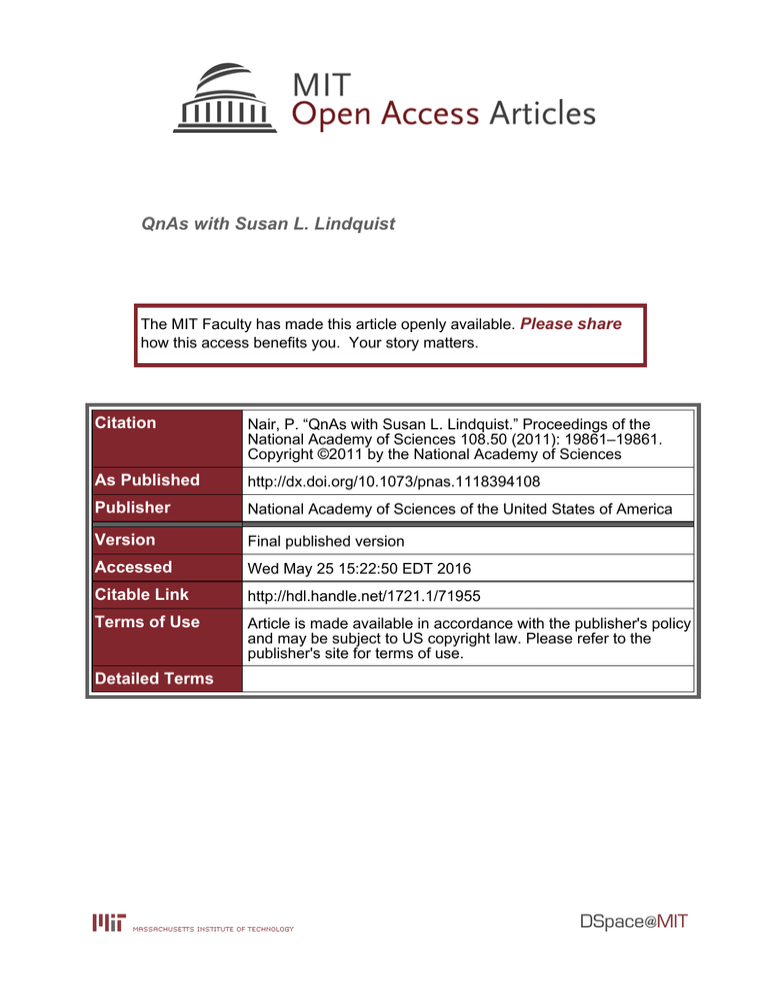
QnAs with Susan L. Lindquist The MIT Faculty has made this article openly available. Please share how this access benefits you. Your story matters. Citation Nair, P. “QnAs with Susan L. Lindquist.” Proceedings of the National Academy of Sciences 108.50 (2011): 19861–19861. Copyright ©2011 by the National Academy of Sciences As Published http://dx.doi.org/10.1073/pnas.1118394108 Publisher National Academy of Sciences of the United States of America Version Final published version Accessed Wed May 25 15:22:50 EDT 2016 Citable Link http://hdl.handle.net/1721.1/71955 Terms of Use Article is made available in accordance with the publisher's policy and may be subject to US copyright law. Please refer to the publisher's site for terms of use. Detailed Terms QnAs QnAs with Susan L. Lindquist P rions defy molecular biology’s central dogma. Misfolded proteins that self-perpetuate, prions were first isolated in the early 1980s as the cause of a fatal sheep disease called scrapie. Since then, prions have been implicated in human neurodegenerative diseases, composing a rogue’s gallery of deadly disease agents. Susan Lindquist, a member of the National Academy of Sciences and a professor of biology at the Massachusetts Institute of Technology’s Whitehead Institute for Biomedical Research, has found that prions may have a little-appreciated positive side. Lindquist casts these seeming biochemical misfits in a surprising evolutionary role: Her studies have revealed that prions might help cells adapt to a host of environmental pressures. Lindquist explains this stillcontentious idea to PNAS readers. PNAS: How did you suspect that prions might have a positive role in cells? Lindquist: We were working on a heat shock protein—Hsp104—involved in a form of stress tolerance in yeast when I got a call from Yury Chernoff. He was studying a mysterious genetic factor that affected the organism’s fidelity of protein translation. He had found that Hsp104 affected the inheritance of this factor. We had reported that Hsp104 allows cells to tolerate stress, but we hadn’t reported how. We knew that Hsp104 takes protein aggregates apart; but we hadn’t been able to get it published because no one would believe us—it was, after all, very unexpected. So we started working with Yury on how a protein folding agent affected the inheritance of this factor. A few months later Reed Wickner published the idea that the mysterious factor was possibly a prion. We showed through biochemical studies that this inherited prion self-perpetuated as an aggregate. In distantly related organisms the gene for the prion is highly conserved, including the sequence of the protein domain that we believed was serving as the aggregation template. The degree of evolutionary conservation of this protein made us wonder whether the prion played a physiologically important role in yeast. PNAS: What did your studies reveal? Lindquist: Indeed, the prion affected the ability of yeast to grow under many different conditions. Yeast cells, which grow in diverse, changing environments, can spontaneously gain or lose prions. Prions might help them rapidly adapt to those environments, such as changes in salt, oxygen, and carbon sources, by conferring new phenotypes. The prions cause the yeast to read their genetic information differently. With www.pnas.org/cgi/doi/10.1073/pnas.1118394108 Susan L. Lindquist. that first prion we looked at, the normal form of the protein—called the translation termination factor—helps ribosomes [cells’ protein synthesizing machinery] recognize stop codons and terminate translation. When that protein switches to its prion form, it is sequestered in an aggregate. As a result, the ribosomes continue translation. That can change the abundance of the protein or produce new proteins that might confer adaptive traits. PNAS: So the prion functions as a switch that can sometimes benefit the organism? Lindquist: Yes, we now know there are lots of these prions; and flipping on the switch to a prion state can turn the function of the protein on or off and potentially provide yeast cells with novel, heritable traits. PNAS: Now the million-dollar question: What triggers the switch? Lindquist: That may be the best part. Prions are fundamentally a protein folding problem. Every once in a while, cells might switch some of their proteins into and out of the prion state, just out of happenstance. We call this a “bet-hedging” strategy; but stress and unfavorable environments cause protein folding problems and increase the frequency of that switch. It’s an illustration of environmental change altering the pace of evolution. It’s very Lamarckian: Heritable traits arise as adaptations before they are hardwired into the genome. PNAS: In collaboration with neuroscientist Eric Kandel you found that prions might influence learning and memory. Can you explain how? Lindquist: Eric Kandel was studying proteins located in synapses that help maintain them in an active, stable state—a biochemical basis for learning and memory. Kausik Si, a postdoc of Kandel’s, found that one of the proteins they were studying had a domain on it that looked like a yeast prion, suggesting that the protein might assemble into an ordered aggregate. So Kandel walked into my office one day, asking whether prions might be involved in memory. We helped them insert their protein into yeast cells; and it did undergo a prion-like conformational switch, rendering the protein active. What we think is happening—and the evidence is getting stronger—is that the protein enters a prion state in nerve cells at certain kinds of synapses and helps make proteins that are involved in building the synapses. That might produce a form of molecular substrate for local memory in the synapse. Further, we have found that when the switch to the prion state occurs, it can result in a handful of self-perpetuating prion states of varying levels of activity that persist for years. So, the thinking goes, this might be a mechanism for maintaining synapses of different strengths. PNAS: Was there skepticism regarding such positive roles for prions, which are largely seen as destructive proteins that cause devastating diseases? Lindquist: It is still a fairly controversial idea. Some people believe it, and others don’t. That said, we’ve found many new prions that seem to suggest that prion switching is a fairly common mechanism to acquire new traitsat least in yeast cells. PNAS: What are the evolutionary im- plications of these beneficial roles played by prions? Lindquist: One of the great conundrums in evolution is how complexity is achieved and inherited. For an organism to evolve novel traits, several spontaneous changes must occur together, and prions illustrate how that might happen in nature all at once. We’ve found that about 25% of the time when a protein switches to a prion state, it allows the organism to acquire beneficial traits. We believe it is fairly widespread in biology. PNAS: Can studying the beneficial properties of prions help address protein aggregation diseases like Parkinson’s disease and Alzheimer’s disease? Lindquist: There is growing evidence to suggest that it may not be the amyloids themselves that are toxic to cells (they are highly stable, inert aggregates) but that it’s the pre-amyloids that wreak havoc in those diseases. Amyloids begin as a sort of oligomeric pre-amyloid state, which we believe many prions are capable of adopting. By studying prions we’re learning that to prevent protein aggregation diseases, we might have to either prevent those proteins from going into the oligomeric state or hasten the transformation of the oligomeric, pre-amyloid state into a stable amyloid state. Prashant Nair, Science Writer PNAS | December 13, 2011 | vol. 108 | no. 50 | 19861

